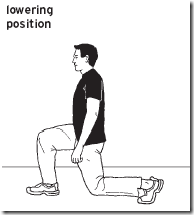Almost every day you will see lunges being performed in the gym. And, almost every day you will see lunges performed incorrectly resulting in knee pain and possibly knee injury. I thought this was a great time to do a review of this very versatile exercise. So here goes:
ANATOMY OF A LUNGE
The lunge is probably one of the most versatile exercises in our strength training tool box. It gives you the biggest bang for your buck. It is also the one exercise that is most often performed incorrectly. Lunges can be an issue for knee health, especially when you lack the glute, hip and posterior chain strength to perform this movement correctly.
Some of the benefits of performing lunges are:
- strengthening the glutes, quadriceps and hamstrings
- improves posture
- develops core strength and stability
- improves balance and coordination
The lunge is one of our primal patterns. This is a movement that is stored in our brains from early development. Unfortunately even though we are born hard wired with this movement pattern, over time we lose the ability to perform it correctly.
How to Perform a Lunge Correctly:
Start with an upright posture. Think of making yourself as tall as possible. This will engage the core muscles. Keeping tight, take an long step out landing on your heel. Lower yourself under control until the back knee almost touches the floor. Once again keeping tight and tall, drive back off the heel to the starting position. A good lunge when performed correctly should look effortless and smooth. You should not see jerking movements through the upper body as you return to the starting position. A longer stride in the lunge will work the glutes, hamstrings and posterior chain more. A short stride lunge will emphasize the quadriceps. Personally, I prefer the long stride lunge as this is also safer for the knee.
Some Common Flaws Seen in a Lunge:
Forward Lean – t
his can be caused by tight hip flexors or quads. Or it can be a simple as being lazy and not working to keep the upper body posture strong throughout. If you are in a hurry to complete the exercise, you may not be focused on keeping tall and this allows the body to lean. Take your time and reset your posture before each rep.
Knees Cave In – If a person has weak glutes they are not able to stabilize adequately or decelerate the hip motion This leads to the knees caving in That is where glute activation exercises (bridges, tube walking) come in. You see there is a reason to be walking back and forth with those dang tubes around your feet!
Foot Caves In – This often seen along with the knees moving in. Typically a muscle imbalance in the lower leg will cause this (tight calf muscles) and weak anterior tibilias muscles. These are the reasons we do the calf stretching, ankle mobility work (specifically the toes up) before and after the workouts
Improper Landing – landing on your toes or pushing off from your toes is usually due to weak muscles around the hip. If you lack the strength in the glutes and posterior chain to get you back to the starting position, then you will push off from your toes utilizing your quad muscles more. Focus on pushing from the heel, not the toes.
Variations and Progressions of the Lunge:
The lunge is an exercise that can be started very basic and progressed to very complex and difficult. Typical progressions of the lunge are:
- static lunge (or split squat)
- reverse lunge
- forward lunge
- walking lunge
- rotating lunges
The progression for load of this exercise is:
- bodyweight lunges
- lunges holding dumbbells
- lunges with barbell on your back
- overhead lunges
I hope this gives you a better understanding of this most beneficial exercise.
Till next time,
Narina

